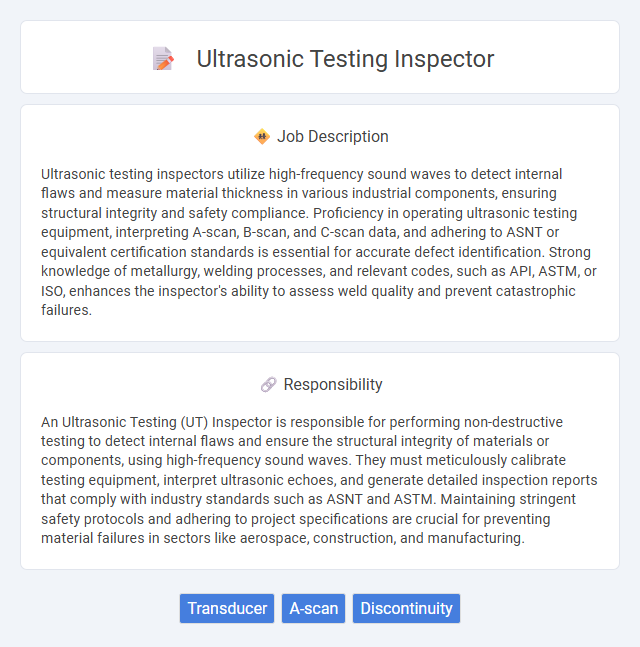
Ultrasonic testing inspectors utilize high-frequency sound waves to detect internal flaws and measure material thickness in various industrial components, ensuring structural integrity and safety compliance. Proficiency in operating ultrasonic testing equipment, interpreting A-scan, B-scan, and C-scan data, and adhering to ASNT or equivalent certification standards is essential for accurate defect identification. Strong knowledge of metallurgy, welding processes, and relevant codes, such as API, ASTM, or ISO, enhances the inspector's ability to assess weld quality and prevent catastrophic failures.
Individuals with strong attention to detail and good hand-eye coordination are likely to be well-suited for an Ultrasonic Testing Inspector role. Those comfortable working in environments that may involve confined spaces or heights might find this job more compatible. A person with a high level of physical stamina and the ability to remain focused for extended periods would probably handle the demands of the position effectively.
Qualification
Ultrasonic testing inspectors must possess certifications such as ASNT Level II or III, demonstrating proficiency in ultrasonic testing techniques and industry standards. A solid background in mechanical engineering or nondestructive testing technology is essential, along with hands-on experience using ultrasonic equipment for detecting material flaws. Strong knowledge of ASTM and ISO standards ensures accurate interpretation of ultrasonic data and compliance with safety regulations.
Responsibility
An Ultrasonic Testing (UT) Inspector is responsible for performing non-destructive testing to detect internal flaws and ensure the structural integrity of materials or components, using high-frequency sound waves. They must meticulously calibrate testing equipment, interpret ultrasonic echoes, and generate detailed inspection reports that comply with industry standards such as ASNT and ASTM. Maintaining stringent safety protocols and adhering to project specifications are crucial for preventing material failures in sectors like aerospace, construction, and manufacturing.
Benefit
Ultrasonic testing inspectors likely benefit from high demand in industries like aerospace, manufacturing, and oil and gas, resulting in stable job prospects. They probably enjoy competitive salaries due to the specialized skills required to detect material flaws accurately. Opportunities for career advancement and certification renewal may enhance long-term professional growth and job security.
Challenge
The ultrasonic testing inspector role likely involves navigating complex material defects and interpreting subtle signals that require high precision and expertise. Challenges in this position probably include maintaining accuracy under varying field conditions and adapting to rapidly evolving inspection technologies. Success depends on a strong analytical mindset and continuous skill development to meet stringent safety and quality standards.
Career Advancement
Ultrasonic testing inspectors skilled in non-destructive testing techniques often advance to roles such as senior NDT technician, quality control supervisor, or NDT manager by gaining certifications like ASNT Level II or III. Mastery of ultrasonic flaw detection, thickness measurement, and pipeline inspection enhances job prospects in industries like oil and gas, aerospace, and manufacturing. Continuous professional development and expertise in advanced ultrasonic equipment significantly increase opportunities for leadership and higher salary positions.
Key Terms
Transducer
Ultrasonic testing inspectors specialize in using transducers to send high-frequency sound waves into materials, identifying defects such as cracks, voids, or inclusions in metals and composites. Proper calibration and selection of the transducer frequency and type are critical for accurate flaw detection and material thickness measurement. Expertise in interpreting signal reflections and amplitudes from transducer data ensures reliable nondestructive testing outcomes and compliance with industry safety standards.
A-scan
Ultrasonic testing inspectors utilize A-scan technology to detect internal flaws and measure material thickness by analyzing reflected sound waves. This method provides real-time, detailed waveform data essential for identifying cracks, voids, and other discontinuities in metals and composites. Expertise in interpreting A-scan signals ensures accurate evaluation of structural integrity in pipelines, welds, and aerospace components.
Discontinuity
Ultrasonic testing inspectors specialize in detecting and evaluating discontinuities such as cracks, porosity, and inclusions within materials using high-frequency sound waves. They employ advanced ultrasonic equipment to measure the size, location, and orientation of flaws, ensuring compliance with industry standards like ASME and ASTM. Accurate identification of discontinuities prevents structural failures in critical applications across aerospace, oil and gas, and manufacturing sectors.
 kuljobs.com
kuljobs.com